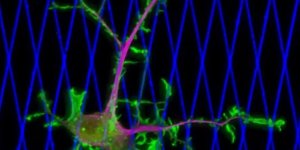| Health / Health News |
Study shows how genes in retina get regulated during development
Researchers at the National Institutes of Health have mapped the 3D organization of genetic material of key developmental stages of human retinal formation, using intricate models of a retina grown in the lab.

This image metaphorically captures the cell differentiation process during retinal organoid development. Loose yarn representing uncompacted DNA is wound by a crochet hook around buttons representing nucleosomes and culminating in a tightly condensed ball of chromatin that forms an eye-like shape. Photo: Erina He/NIH Medical Arts
The findings lay a foundation for understanding clinical traits in many eye diseases, and reveal a highly dynamic process by which the architecture of chromatin, the DNA and proteins that form chromosomes, regulates gene expression.
“These results provide insights into the heritable genetic landscape of the developing human retina, especially for the most abundant cell types that are commonly associated with vision impairment in retinal diseases,” said the study’s lead investigator, Anand Swaroop, Ph.D., chief of the Neurobiology, Neurodegeneration, and Repair Laboratory at the National Eye Institute (NEI), part of NIH.
Using deep Hi-C sequencing, a tool used for studying 3D genome organization, the researchers created a high-resolution map of chromatin in a human retinal organoid at five key points in development.
Organoids are tissue models grown in a lab and engineered to replicate the function and biology of a specific type of tissue in a living body.
Genes, the sequences that code for RNA and proteins, are interspersed throughout long strands of DNA. Those DNA strands get packaged into chromatin fibers, which are spooled around histone proteins and then repeatedly looped to form highly compact structures that fit into the cell nucleus.
All those loops create millions of contact points where genes encounter non-coding DNA sequences, such as super enhancers, promoters, and silencers that regulate gene expression.
Long considered “junk DNA”, these non-coding sequences are now recognized to play a crucial role in controlling which genes get expressed in a cell and when.
Studies of chromatin’s 3D architecture shed light on how these non-coding regulatory elements exert control even when their location on a DNA strand is remote from the genes they regulate.
At each of the five key retinal organoid developmental stages, billions of chromatin contact point pairs were sequenced and analyzed.
The findings reveal a dynamic picture: Spatial organization of the genome within the nucleus is transformed during retinal development, facilitating expression of specific genes at key time periods.
For example, at a stage when immature cells start developing retinal cell characteristics, chromatin contact points shift from a mostly proximal-enriched state to add more distal interactions.
There also appears to be a hierarchy of compartments that organize the contact point interactions. Some of these compartments, called “A” and “B”, are stable, but others swap during development, which further serves to enhance or inhibit gene expression.
YOU MAY ALSO LIKE





